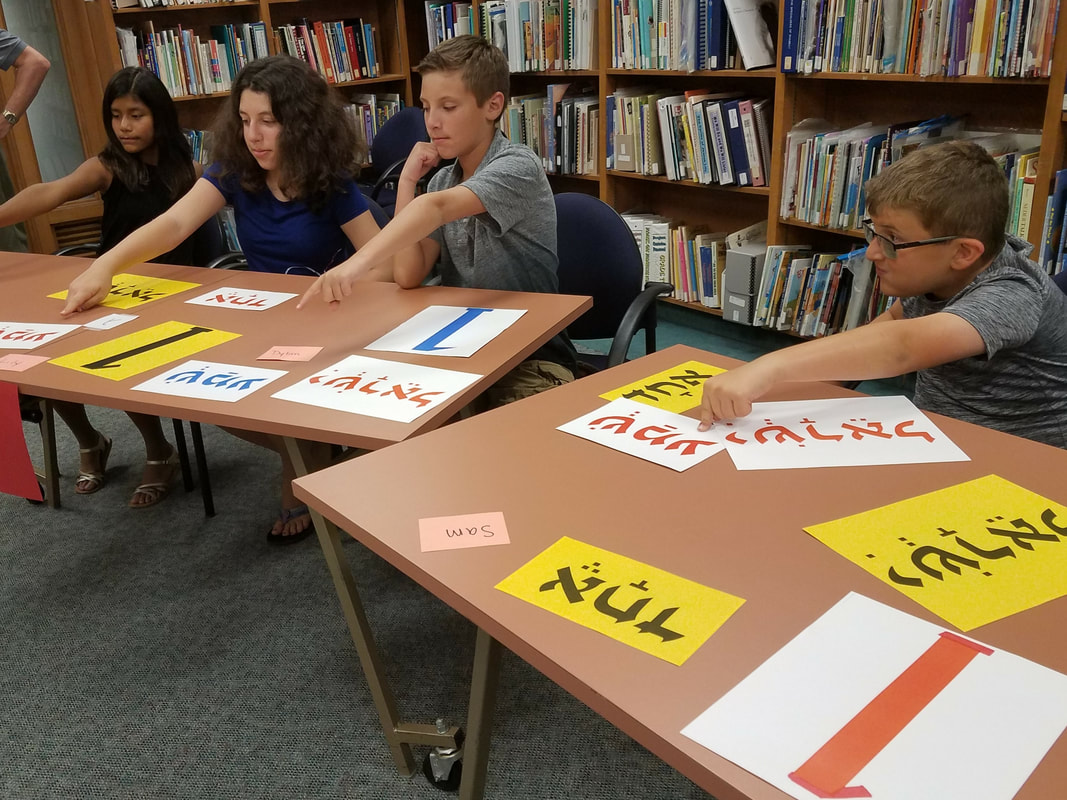 by, Nachama Skolnik Moskowitz Lots of links below! Click on the underlined words and phrases! We live in a time when decades old assumptions about Hebrew and Jewish learning in synagogue/part-time settings are being turned on their head. The time devoted to formal learning has been decreasing and many alternative models have moved from “pilots” to “givens.” As noted in a number of recent articles, #OnwardHebrew is transforming Hebrew learning in part-time/synagogue settings across North America – introducing aural Hebrew language via Hebrew Through Movement, Jewish Life Vocabulary, and regular t’fillot, before teaching Hebrew decoding/reading in the year or two prior to Bar/Bat Mitzvah. There is no doubt that children can learn the Hebrew phonetic system in second or third grade; they have been doing it for decades. However, for too many young students, frustration starts mounting in the year immediately following the introduction of the letters and vowel signs, not because the children are not smart enough and not because their brains can’t figure out phonics in a system that uses different symbols. They face three key challenges: decreased time, lack of foundational knowledge and diminished motivation. DECREASED TIME: Over the last 10-15 years, the days and hours per week for Hebrew learning has decreased in part-time/congregational programs across North America. There is no doubt that this structural change demands a rethinking of Hebrew goals, learning assumptions and approaches. From just the standpoint of time, it does not seem realistic to ask our students to achieve the same goals as earlier generations who had many more hours per week and year. In our part-time settings, we simply do not have time to teach communicative language, nor writing, nor reading for meaning. On the other hand, we can offer rich and engaging Hebrew learning opportunities. LACK OF FOUNDATIONAL KNOWLEDGE: Early English readers who confront the printed word “cat” will sound it out “c-at” and realize that they have heard the word many times before, can pronounce it accurately and know what it means. It is a lightbulb moment! On the other hand, children learning to decode Hebrew who confront the printed word בִּמְרוֹמָיו can get stuck (“Bimmm... wait, is that third letter a D sound or an R? Is that an ‘oh’ in the middle, or is that an ‘oh’ at the end?”). Thus, #OnwardHebrew’s push to delay decoding is to offer years during which students can build foundational knowledge, i.e., aural/oral repertoire of Hebrew prayers, blessings and general vocabulary. The word בִּמְרוֹמָיו, when found in context of עוֹשֶׂה שָׁלוֹם (oseh shalom) becomes an easy sound-to-print progression just like the word “cat” was all those years ago. The student recognizes the phrase/word from having participated in many worship experiences and can pronounce it accurately. If students were lucky enough to learn the meaning of Oseh Shalom’s key words via Hebrew Through Movement, they will also have a context for understanding its meaning. DIMINISHED MOTIVATION: An eight year old is often excited to enter the “club” of those who learn to read Hebrew. However, years of “the same, the same” – even with great textbooks and creative teachers – can wear down the early excitement, creating diminished motivation. On the other hand, students who are a year away from their Bar or Bat Mitzvah bring a maturity for the learning process and stronger motivation for achieving performance goals. In a one-on-one setting, they can learn to decode/read Hebrew letters and vowel signs in 12-15 hours, followed by the normative number of meetings his/her synagogue requires with a B’Mitzvah tutor. So, rather than spending years of Hebrew and prayer rote practice, #OnwardHebrew’s compacted approach for learning Hebrew builds foundational knowledge while suddenly opening up time for more compelling Jewish learning. In an era where Jewish educators talk about Jewish learning for “thriving” and “meaning-making,” transforming the Hebrew learning approach has the potential to benefit the entire Jewish educational enterprise. A few words of advice from those who have been down this path: JOIN THE CONVERSATION: Learn as much as you can by grabbing a cup of coffee (or ice cream!) and then spending an hour or so on the #OnwardHebrew site, clicking on articles and videos. Join the #OnwardHebrew Facebook group, paying attention to the postings; feel free to ask questions or offer your own comments. EXPAND THE CONVERSATION: Stir #OnwardHebrew conversations among stakeholders – clergy, teachers, committee and board members – by sharing and discussing the articles and videos you feel would resonate. PICK SOME LOW HANGING FRUIT: With your stakeholders, decide if you are ready to pilot one or more of the #OnwardHebrew elements – Hebrew Through Movement (make sure your teacher(s) sign up for the online seminar!) Jewish Life Vocabulary (LOTS of resources here – keep clicking around!) and Hebrew t’fillot. Each of these easily complements any of your other current Hebrew learning goals, curriculum or textbooks. Keep in mind that there is potential crossover between these elements. For example you can anchor JLV in the Hebrew alef-bet, introducing one letter a week and teaching two to three Hebrew words that start with it. Thus, a child in your program from first grade onwards would have had six years of seeing most of the letters prior to learning to decode. OR, integrate Hebrew sight words into your Hebrew Through Movement lessons (the picture on at the bottom of this blogpost is from an HTM lesson on Sh’ma). Taken together, #OnwardHebrew’s low hanging fruit are examples of rich Hebrew learning, even without the introduction of decoding until children have gained years of Hebrew vocabulary. CONSIDER WHEN TO TEACH DECODING: Do not rush this decision - it takes open conversation with stakeholders (clergy, parents and teachers), as well as the implementation of some experiments or pilots. For example, consider experimenting with “Let’s Learn Hebrew Side-by-Side” for any children who enter your program in fifth or sixth grade not having yet learned to decode/read Hebrew. Or, exchange traditional letter recognition learning in K, 1 and 2, with Hebrew Through Movement. Or, follow the lead of some educational programs that remove decoding from second and third grade with a target grade of where they will introduce it later (e.g., fifth grade), but keep open the possibility of changing that time of introduction. And be sure to evaluate the process and results when done! # # # Kol hakavod for considering the question! Stay in touch with the #OnwardHebrew if you need help! The "Contact Form" is a great way to connect in. Want to share this post? A PDF of this posting is below.
1 Comment
 Recently, I’ve been thinking about Gutenberg’s printing press and its harsh impact on Hebrew School. And indeed, initial drafts of this blog post began as a tirade against Gutenberg, blaming him for the struggles of many a child in Hebrew School. For if he hadn’t invented the ability to print prayerbooks in mass quantities, then worshipers wouldn’t have books in their hands, and Jewish children would not have to struggle with learning to decode Hebrew over four to six years in the learning environment known as “Hebrew School.” Yikes! It got a little complicated as I realized I couldn’t blame Gutenberg alone – the Enlightenment, Industrial Revolution and a host of other factors could also be implicated in the path to creating the current model of Hebrew learning in part-time/congregational settings. But here’s the point – two thousand years ago, Jewish prayers were shared orally, not slogged through by those learning to decode Hebrew. In the days of scribes and scrolls, an inspirational person who understood the structure of traditional worship led the community in a strong, clear voice. The people could and would do any number of things: listen, recite along with the worship leader, repeat lines or simply say amen. Prayer was an outpouring of the heart that transcended the printed page … oh, wait, there was no printed page at that time! The first written prayerbook was a letter sent by one rabbi to the community of Barcelona in the 9th century CE, and it was not until the mid-15th century that Gutenberg’s printing press made it possible to more easily duplicate copies of books. BUT, over the last few decades, we as Jewish educators have twisted ourselves into tight knots teaching our students what we assume is the one and only way to pray – book in hand, eyes following the print on the page, and using skills of decoding to stay up with the service. And how do we know (hmm, test) that students can participate comfortable in Hebrew worship? Often prior to b’nai mitzvah tutoring, someone checks their reading fluency by handing them a piece of Hebrew text that they have never seen before and asking them to read aloud. Many children struggle, some cry. Most of us learned to read as a young child because over five to six years of listening and eventually talking, we built an incredibly large vocabulary and kishke-understanding of English’s structure. A child who sounds out c-a-t often has a light bulb moment – “Oh wait, I know that word! Cat!!” But children who are asked to sound out Hebrew prayer words they don’t know and may never understand because of adult-complexity and prosaic structure (like בְּמִשְׁמְרוֹתֵיהֶם) are caught like deer in the headlights. The “I-know-that-word!”-light-bulb-moment never comes. #OnwardHebrew suggests that we go back to our roots, introducing new learners to Jewish prayer orally, without concern that they have memorized the text (oh my!) before being able to relate to the printed page. Competent and confident pray-ers are not defined by “decoding to synagogue speed with two or fewer mistakes.” In fact, it’s rather impossible to decode to synagogue speed; one HAS to have the prayers and blessings in one’s head and heart (a softer way to describe “memorize”) to stay up with the service. Besides emphasizing the singing or reciting of Hebrew prayers and blessings in t’fillah (worship), #OnwardHebrew also suggests spending years of building the sounds of Hebrew language in the hearts of our learners in other ways – Hebrew Through Movement (a fun, kinesthetic way to learn key vocabulary of holidays, prayers and blessings) and Jewish Life Vocabulary (Hebrew words that are integrated into English sentences – “What a sneeze! Labri-ut!” or “Grab your siddur, we are going to t’fillah”). Children closer to the age of bar/bat mitzvah who have richly built the sounds of Hebrew can quickly and easily learn the Alef-Bet (12-15 hours) and then match this new skill with the words and phrases now gloriously floating in their heads (oh, yes, and hearts). While I’ve moved on from blaming Gutenberg, I yearn for a return to the days of scribes, scrolls and the aural/oral learning and transmission of prayers and blessings. I challenge us as Jewish educators to release ourselves from the decades old (not millennia old) tradition of teaching in which our students often painfully decode prayers and blessings, syllable-by-syllable, word-by-word. No, I am not suggesting that we skip teaching Hebrew decoding/reading altogether. But for the sake of our young learners, I am pushing us to become more savvy about the process and more efficient with our time. If we can affect this change in our curriculum, releasing our students from years of frustrating work with pre-primers, primers, prayers and blessings, then amazingly we will have more time for engaging, meaningful and compelling Jewish learning ... which is what the Jewish educational enterprise should be about! #OnwardHebrew!! Join the conversation here (comments are welcome, below) and on Facebook! Kol tuv ("all the best") <<just a little Jewish Life Vocabulary thrown in! Nachama Skolnik Moskowitz, Director of Curriculum Resources Jewish Education Center of Cleveland We are excited to share supports for the integration of Jewish Life Vocabulary, offering you avenues for introducing your community to Hebrew words and phrases by infusing them into English sentences ("What an interesting argument! I'd say eilu v'eilu - it's both this and that!"). On our JLV webpages you'll find:
Note that documents have been offered both as PDFs (so that the formatting and Hebrew font "holds") and in Word so that you may edit the lists as desired, adding or subtracting vocabulary that better fits your community. Do you have unique ideas for integrating JLV into your educational program? Please share with the rest of us - either via the contact form on the homepage of this website OR by creating a post in the Facebook group. Questions, comments and corrections are welcome, too! |
AuthorSAll of us! If you have something to contribute, send your posting via the Contact webpage! Archives
September 2023
Categories
All
|
||||||

 RSS Feed
RSS Feed